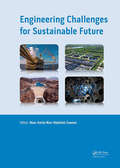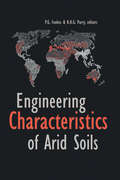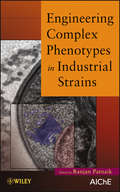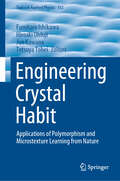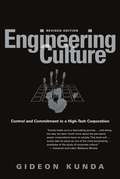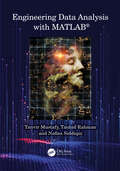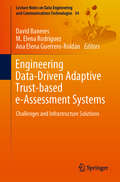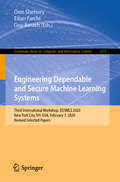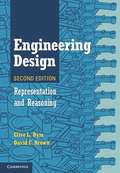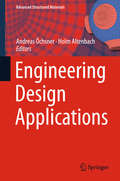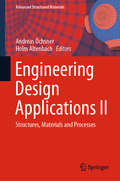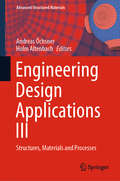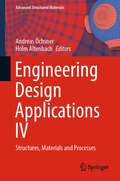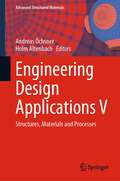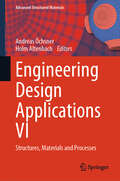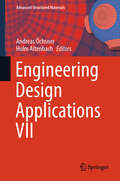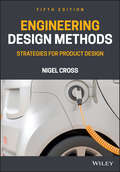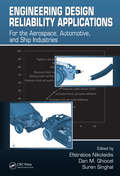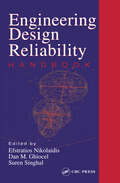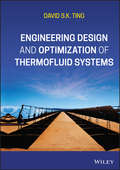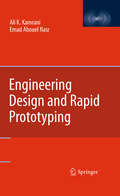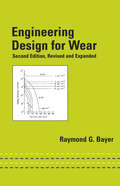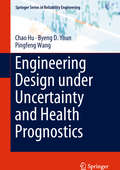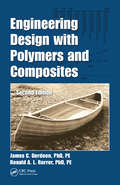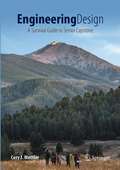- Table View
- List View
Engineering Challenges for Sustainable Future: Proceedings of the 3rd International Conference on Civil, Offshore and Environmental Engineering (ICCOEE 2016, Malaysia, 15-17 Aug 2016)
by Noor Amila Wan Abdullah ZawawiEngineering Challenges for Sustainable Future contains the papers presented at the 3rd International Conference on Civil, Offshore & Environmental Engineering (ICCOEE2016, Kuala Lumpur, Malaysia, 15-17 August 2016), under the banner of World Engineering, Science & Technology Congress (ESTCON2016). The ICCOEE series of conferences started in Kuala Lumpur, Malaysia 2012, and the second event of the series took place in Kuala Lumpur, Malaysia 2014. This conference series deals with the civil, offshore & environmental engineering field, addressing the following topics:• Environmental and Water Resources Engineering• Coastal and Offshore Engineering• Structures and Materials• Construction and Project Management• Highway, Geotechnical and Transportation Engineering and Geo-informatics This book is an essential reading for academic, engineers and all professionals involved in the area of civil, offshore and environmental engineering.
Engineering Characteristics of Arid Soils
by P.G. Fookes and R.H.G. ParrySoils formed or now existing under arid climatic conditions cover more than one-third of the world's land surface. Many have unique characteristics which can pose difficult geotechnical problems. This text considers these problems and suggests ways of overcoming them.
Engineering Complex Phenotypes in Industrial Strains
by Ranjan PatnaikThis book highlights current trends and developments in the area of engineering strains. The book details the current and future tools used in the production of bulk chemicals and biofuels from renewable biomass using green technologies. Complex phenotypes are traits in a microbe that requires multiple genetic changes to be modulated simultaneously in the microorganism's DNA. Knowing what those genetic changes are for a given trait and how to make those changes in the most efficient way forms the motivation behind writing this book. This book explains the newer tools to develop and enable engineered strains at time scales much faster that the natural evolution process so that we can increase a cells' production of a certain substance, increase process productivity, and extend metabolic capability. This book provides a one stop platform of reference for practicing researchers in the field of industrial biotechnology. This book also explains that the commercial success of a process that uses microbial catalysts over platforms that use chemical catalysts and fossil fuels depends on the time it takes to engineer these microbes to perform the desired reaction under harsh manufacturing conditions and at rates that meets the criteria for economic feasibility.
Engineering Crystal Habit: Applications of Polymorphism and Microstexture Learning from Nature (Topics in Applied Physics #152)
by Fumitaro Ishikawa Hiroaki Ohfuji Jun Kawano Tetsuya ToheiThis book compiles reviews of both fundamental and applied research in physics and materials science, focusing on the existence, formation mechanisms, and artificial synthesis of versatile, nature-inspired crystals. It aims to highlight the development and application of advanced crystals with novel polymorphism and microtextures, resulting in the innovation of completely new and unexpected functionality. The book encompasses five main topics; the first three focus on fundamental research in mineralogy in the areas of polymorphism and microtexture in biological environments, crystallographic structure, and nucleation and growth. The last two parts address applied research devoted to microtexture and polymorphism in electronics and photonics applications. The featured topics comprise contributions from international groups of active researchers in the field. The book is a valuable tool for a wide readership ranging from graduate students to researchers and engineers. The broad coverage of topics is attractive to readers from diverse fields including crystal engineering, drug development, electronic materials, electronic devices, and mineralogy.
Engineering Culture: Control and Commitment in a High-Tech Corporation
by Gideon KundaEngineering Culture is an award-winning ethnography of the engineering division of a large American high-tech corporation. Now, this influential book—which has been translated into Japanese, Italian, and Hebrew—has been revised to bring it up to date. In Engineering Culture, Gideon Kunda offers a critical analysis of an American company's well-known and widely emulated "corporate culture. " Kunda uses detailed descriptions of everyday interactions and rituals in which the culture is brought to life, excerpts from in-depth interviews and a wide variety of corporate texts to vividly portray managerial attempts to design and impose the culture and the ways in which it is experienced by members of the organization. The company's management, Kunda reveals, uses a variety of methods to promulgate what it claims is a non-authoritarian, informal, and flexible work environment that enhances and rewards individual commitment, initiative, and creativity while promoting personal growth. The author demonstrates, however, that these pervasive efforts mask an elaborate and subtle form of normative control in which the members' minds and hearts become the target of corporate influence. Kunda carefully dissects the impact this form of control has on employees' work behavior and on their sense of self. In the conclusion written especially for this edition, Kunda reviews the company's fortunes in the years that followed publication of the first edition, reevaluates the arguments in the book, and explores the relevance of corporate culture and its management today.
Engineering Data Analysis with MATLAB®
by Tanvir Mustafy Tauhid Rahman Nafisa SiddiquiThis book provides a concise overview of a variety of techniques for analyzing statistical, scientific, and financial data, using MATLAB® to integrate several approaches to data analysis and statistics. The chapters offer a broad review of computational data analysis, illustrated with many examples and applications. Topics range from the basics of data and statistical analysis to more advanced subjects such as probability distributions, descriptive and inferential statistics, parametric and non-parametric tests, correlation, and regression analysis. Each chapter combines theoretical concepts with practical MATLAB® applications and includes practice exercises, ensuring a comprehensive understanding of the material. With coverage of both basic and more complex ideas in applied statistics, the book has broad appeal for undergraduate students up to practicing engineers.
Engineering Data-Driven Adaptive Trust-based e-Assessment Systems: Challenges and Infrastructure Solutions (Lecture Notes on Data Engineering and Communications Technologies #34)
by David Baneres M. Elena Rodríguez Ana Elena Guerrero-RoldánThis book shares original innovations, research, and lessons learned regarding teaching and technological perspectives on trust-based learning systems. Both perspectives are crucial to enhancing the e-Assessment process. In the course of the book, diverse areas of the computer sciences (machine learning, biometric recognition, cloud computing, and learning analytics, amongst others) are addressed. In addition, current trends, privacy, ethical issues, technological solutions, and adaptive educational models are described to provide readers with a global view on the state of the art, the latest challenges, and potential solutions in e-Assessment. As such, the book offers a valuable reference guide for industry, educational institutions, researchers, developers, and practitioners seeking to promote e-Assessment processes.
Engineering Dependable and Secure Machine Learning Systems: Third International Workshop, EDSMLS 2020, New York City, NY, USA, February 7, 2020, Revised Selected Papers (Communications in Computer and Information Science #1272)
by Onn Shehory Eitan Farchi Guy BarashThis book constitutes the revised selected papers of the Third International Workshop on Engineering Dependable and Secure Machine Learning Systems, EDSMLS 2020, held in New York City, NY, USA, in February 2020. The 7 full papers and 3 short papers were thoroughly reviewed and selected from 16 submissions. The volume presents original research on dependability and quality assurance of ML software systems, adversarial attacks on ML software systems, adversarial ML and software engineering, etc.
Engineering Design
by Clive L. Dym David C. BrownContrary to popular mythology, the designs of favorable products and successful systems do not appear suddenly, or magically. This second edition of Engineering Design demonstrates that symbolic representation and related problem-solving methods, offer significant opportunities to clarify and articulate concepts of design to lay a better framework for design research and design education. Artificial Intelligence (AI) provides a substantial body of material concerned with understanding and modeling cognitive processes. This book adopts the vocabulary and a paradigm of AI to enhance the presentation and explanation of design. It includes concepts from AI because of their explanatory power and their utility as possible ingredients of practical design activity. This second edition has been enriched by the inclusion of recent work on design reasoning, computational design, AI in design, and design cognition, with pointers to a wide cross section of the current literature.
Engineering Design Applications (Advanced Structured Materials #92)
by Andreas Öchsner Holm AltenbachThis volume gives an overview on recent developments for various applications of modern engineering design. Different engineering disciplines such as mechanical, materials, computer and process engineering provide the foundation for the design and development of improved structures, materials and processes. The modern design cycle is characterized by an interaction of different disciplines and a strong shift to computer-based approaches where only a few experiments are performed for verification purposes. A major driver for this development is the increased demand for cost reduction, which is also connected to environmental demands. In the transportation industry (e.g. automotive or aerospace), this is connected with the demand for higher fuel efficiency, which is related to the operational costs and the lower harm for the environment. One way to fulfil such requirements are lighter structures and/or improved processes for energy conversion. Another emerging area is the interaction of classical engineering with the health and medical sector. In this book, many examples of the mentioned design applications are presented.
Engineering Design Applications II: Structures, Materials and Processes (Advanced Structured Materials #113)
by Andreas Öchsner Holm AltenbachThis book offers an update on recent developments in modern engineering design. Different engineering disciplines, such as mechanical, materials, computer and process engineering, provide the foundation for the design and development of improved structures, materials and processes. The modern design cycle is characterized by the interaction between various disciplines and a strong shift to computer-based approaches where only a few experiments are conducted for verification purposes. A major driver for this development is the increased demand for cost reduction, which is also linked to environmental demands. In the transportation industry (e.g. automotive or aerospace), the demand for higher fuel efficiency is related to reduced operational costs and less environmental damage. One way to fulfil such requirements is lighter structures and/or improved processes for energy conversion. Another emerging area is the interaction of classical engineering with the health and medical sector.
Engineering Design Applications III: Structures, Materials and Processes (Advanced Structured Materials #124)
by Andreas Öchsner Holm AltenbachThis book provides an update on recent advances in various areas of modern engineering design, such as mechanical, materials, computer, and process engineering, which provide the foundation for the development of improved structures, materials, and processes. The modern design cycle is characterized by the interaction of different disciplines and a strong shift toward computer-based approaches involving only a small number of experiments for verification purposes. A major driver for this development is the increased demand for cost reduction, which is also connected to environmental demands. In the transportation industry (e.g. automotive or aerospace), where there is a demand for greater fuel efficiency, one solution is lighter structures and/or improved processes for energy conversion. Another emerging area is the interaction of classical engineering with the health and medical sector.
Engineering Design Applications IV: Structures, Materials and Processes (Advanced Structured Materials #172)
by Andreas Öchsner Holm AltenbachThis book presents the developments in engineering design application. The chapters on mechanical, materials, computer and process engineering provide the foundation for the design and development of improved structures, materials and processes. They present alternatives with cost reduction and environmental demands. The book content links the interaction of classical engineering with the health, medical and environmental sector.
Engineering Design Applications V: Structures, Materials and Processes (Advanced Structured Materials #171)
by Andreas Öchsner Holm AltenbachThis book gives an update on recent developments in different engineering disciplines such as mechanical, materials, computer and process engineering, focusing on modern engineering design applications. These disciplines provide the foundation for the design and development of improved structures, materials and processes. The modern design cycle is characterized by an interaction of different disciplines and a strong shift to computer-based approaches where only a few experiments are performed for verification purposes. A major driver for this development is the increased demand for cost reduction, which is also connected to environmental demands. In the transportation industry (e.g., automotive), this is connected to the demand for higher fuel efficiency, which is related to the operational costs and the lower harm for the environment. One way to fulfill such requirements is lighter structures and/or improved processes for energy conversion. Another emerging area is the interaction of classical engineering with the health, medical and environmental sector. The chapters are selected contributions of the Advanced Computational Engineering and Experimenting conference, held in July 2022 in Florence, Italy.
Engineering Design Applications VI: Structures, Materials and Processes (Advanced Structured Materials #209)
by Andreas Öchsner Holm AltenbachThis book gives an update on recent developments in the mentioned areas of modern engineering design application. Different engineering disciplines such as mechanical, materials, computer and process engineering provide the foundation for the design and development of improved structures, materials and processes. The modern design cycle is characterized by an interaction of different disciplines and a strong shift to computer-based approaches where only a few experiments are performed for verification purposes. A major driver for this development is the increased demand for cost reduction, which is also connected to environmental demands. In the transportation industry (e.g. automotive), this is connected with the demand for higher fuel efficiency, which is related to the operational costs and the lower harm for the environment. One way to fulfil such requirements are lighter structures and/or improved processes for energy conversion. Another emerging area is the interaction of classical engineering with the health, medical, and environmental sectors.
Engineering Design Applications VII (Advanced Structured Materials #230)
by Andreas Öchsner Holm AltenbachThis book gives an update on recent developments in the mentioned areas of modern engineering design application. Different engineering disciplines such as mechanical, materials, computer, and process engineering provide the foundation for the design and development of improved structures, materials, and processes. The modern design cycle is characterized by an interaction of different disciplines and a strong shift to computer-based approaches where only a few experiments are performed for verification purposes. A major driver for this development is the increased demand for cost reduction and higher efficiency, which is also connected to environmental demands. One way to fulfil such requirements is lighter structures and/or new composite materials and structures. Another emerging area is the interaction of classical engineering with the health, medical, and environmental sector.
Engineering Design Methods: Strategies for Product Design
by Nigel CrossA revised text that presents specific design methods within an overall strategy from concept to detail design The fifth edition of Engineering Design Methods is an improved and updated version of this very successful, classic text on engineering product design. It provides an overview of design activities and processes, detailed descriptions and examples of how to use key design methods, and outlines design project strategies and management techniques. Written by a noted expert on the topic, the new edition contains an enriched variety of examples and case studies, and up to date material on design thinking and the development of design expertise. This new edition opens with a compelling original case study of a revolutionary new city-car design by ex-Formula One designer Gordon Murray. The study illustrates the complete development of a novel design and brings to life the process of design, from concept through to prototype. The core of the book presents detailed instructions and examples for using design methods throughout the design process, ranging from identifying new product opportunities, through establishing functions and setting requirements, to generating, evaluating and improving alternative designs. This important book: Offers a revised and updated edition of an established, successful text on understanding the design process and using design methods Includes new material on design thinking and design ability and new examples of the use of design methods Presents clear, detailed and illustrated presentations of eight key design methods in engineering product design Written for undergraduates and postgraduates across all fields of engineering and product design, the fifth edition of Engineering Design Methods offers an updated, substantial, and reliable text on product design and innovation.
Engineering Design Reliability Applications: For the Aerospace, Automotive and Ship Industries
by Efstratios Nikolaidis Dan M. Ghiocel Suren SinghalIn the current, increasingly aggressive business environment, crucial decisions about product design often involve significant uncertainty. Highlighting the competitive advantage available from using risk-based reliability design, Engineering Design Reliability Applications: For the Aerospace, Automotive, and Ship Industries provides an overview of
Engineering Design Reliability Handbook
by Efstratios Nikolaidis Dan M. Ghiocel Suren SinghalResearchers in the engineering industry and academia are making important advances on reliability-based design and modeling of uncertainty when data is limited. Non deterministic approaches have enabled industries to save billions by reducing design and warranty costs and by improving quality.Considering the lack of comprehensive and defini
Engineering Design and Optimization of Thermofluid Systems
by David S. TingA practical and accessible introductory textbook that enables engineering students to design and optimize typical thermofluid systems Engineering Design and Optimization of Thermofluid Systems is designed to help students and professionals alike understand the design and optimization techniques used to create complex engineering systems that incorporate heat transfer, thermodynamics, fluid dynamics, and mass transfer. Designed for thermal systems design courses, this comprehensive textbook covers thermofluid theory, practical applications, and established techniques for improved performance, efficiency, and economy of thermofluid systems. Students gain a solid understanding of best practices for the design of pumps, compressors, heat exchangers, HVAC systems, power generation systems, and more. Covering the material using a pragmatic, student-friendly approach, the text begins by introducing design, optimization, and engineering economics—with emphasis on the importance of engineering optimization in maximizing efficiency and minimizing cost. Subsequent chapters review representative thermofluid systems and devices and discuss basic mathematical models for describing thermofluid systems. Moving on to system simulation, students work with the classical calculus method, the Lagrange multiplier, canonical search methods, and geometric programming. Throughout the text, examples and practice problems integrate emerging industry technologies to show students how key concepts are applied in the real world. This well-balanced textbook: Integrates underlying thermofluid principles, the fundamentals of engineering design, and a variety of optimization methods Covers optimization techniques alongside thermofluid system theory Provides readers best practices to follow on-the-job when designing thermofluid systems Contains numerous tables, figures, examples, and problem sets Emphasizing optimization techniques more than any other thermofluid system textbook available, Engineering Design and Optimization of Thermofluid Systems is the ideal textbook for upper-level undergraduate and graduate students and instructors in thermal systems design courses, and a valuable reference for professional mechanical engineers and researchers in the field.
Engineering Design and Rapid Prototyping
by Ali K. Kamrani Emad Abouel Nasr"Engineering Design and Rapid Prototyping" offers insight into the methods and techniques that allow for easily implementing engineering designs by incorporating advanced methodologies and technologies. This book contains advanced topics such as feature-based design and process planning, modularity and rapid manufacturing, along with a collection of the latest methods and technologies currently being utilized in the field. The volume also: -Provides axiomatic design and solution methodologies for both design and manufacturing -Discusses product life cycle development and analysis for ease of manufacture and assembly -Offers applied methods and technologies in rapid prototyping, tooling and manufacturing "Engineering Design and Rapid Prototyping" will be extremely valuable for any engineers and researchers and students working in engineering design.
Engineering Design for Wear, Revised and Expanded (Mechanical Engineering)
by Raymond G. BayerA modern presentation of approaches to wear design, this significantly revised and expanded second edition offers methods suited for meeting specific wear performance requirements, numerous design studies highlighting strategies for use with different tribological elements and mechanical systems, proven tactics for resolving wear-related problems,
Engineering Design under Uncertainty and Health Prognostics (Springer Series in Reliability Engineering)
by Chao Hu Byeng D. Youn Pingfeng WangThis book presents state-of-the-art probabilistic methods for the reliability analysis and design of engineering products and processes. It seeks to facilitate practical application of probabilistic analysis and design by providing an authoritative, in-depth, and practical description of what probabilistic analysis and design is and how it can be implemented. The text is packed with many practical engineering examples (e.g., electric power transmission systems, aircraft power generating systems, and mechanical transmission systems) and exercise problems. It is an up-to-date, fully illustrated reference suitable for both undergraduate and graduate engineering students, researchers, and professional engineers who are interested in exploring the fundamentals, implementation, and applications of probabilistic analysis and design methods.
Engineering Design with Polymers and Composites
by James C. Gerdeen PhD PE Ronald A.L. Rorrer PhD PEEngineering Design with Polymers and Composites, Second Edition continues to provide one of the only textbooks on the analysis and design of mechanical components made from polymer materials. It explains how to create polymer materials to meet design specifications. After tracing the history of polymers and composites, the text describes modern des
Engineering Design: A Survival Guide to Senior Capstone
by Cory J. MettlerEngineering Senior Design is perhaps the course that most resembles what an engineering professional will be required to do during their career; it is the bridge between the academic classroom and the engineering profession. This textbook will support students as they learn to apply their previously-developed skills to solve a complex engineering problem during a senior-level design course. This textbook follows the design life cycle from project initiation to completion and introduces students to many soft engineering skills, such as communication, scheduling, and technical writing, in the context of an engineering design. Students are instructed how to define an engineering problem with a valid problem statement and requirements document. They will conceptualize a complex solution and divide that solution into manageable subsystems. More importantly, they will be introduced to Project Management techniques that will help students organize workloads, develop functional engineering-teams, and validate solutions, all while increasing the likelihood of a successful completion to the project. Throughout the experience, students are instructed that a well-intentioned solution is not particularly useful unless it can be communicated and documented. To that end, this textbook will help students document their work in a professional manner and to present their ideas to stakeholders in a variety of formal design-reviews. With the support of this textbook, by the end of a student’s senior design experience, each individual will be ready to communicate with other engineering professionals, effectively support engineering design-teams, and manage complex project to solve the next generation’s engineering challenges.
